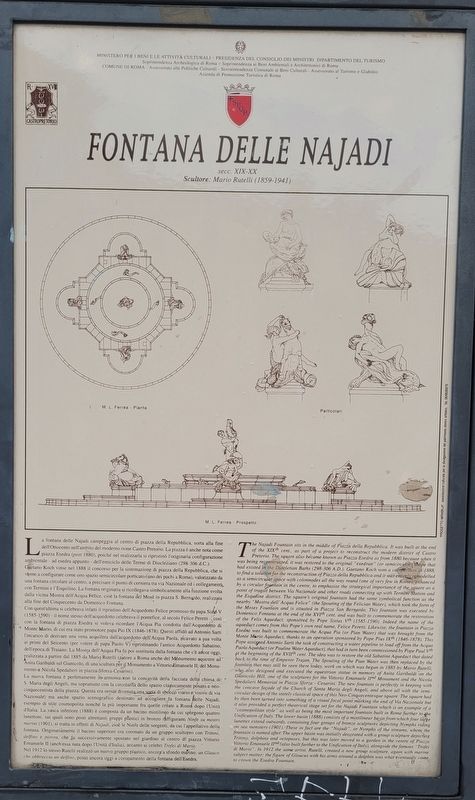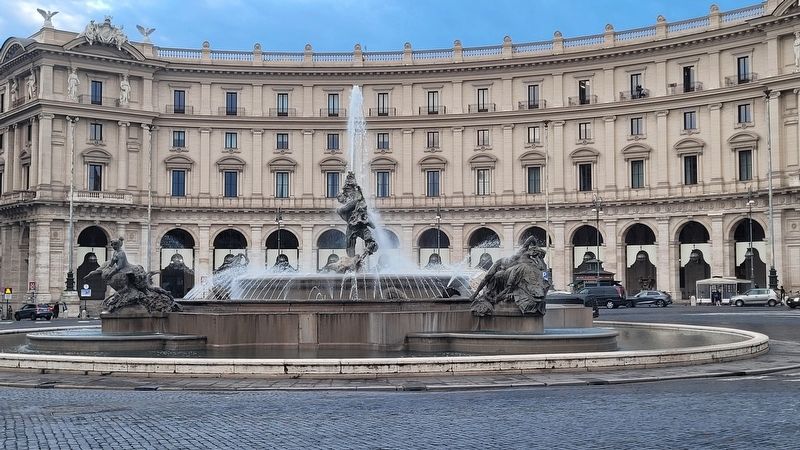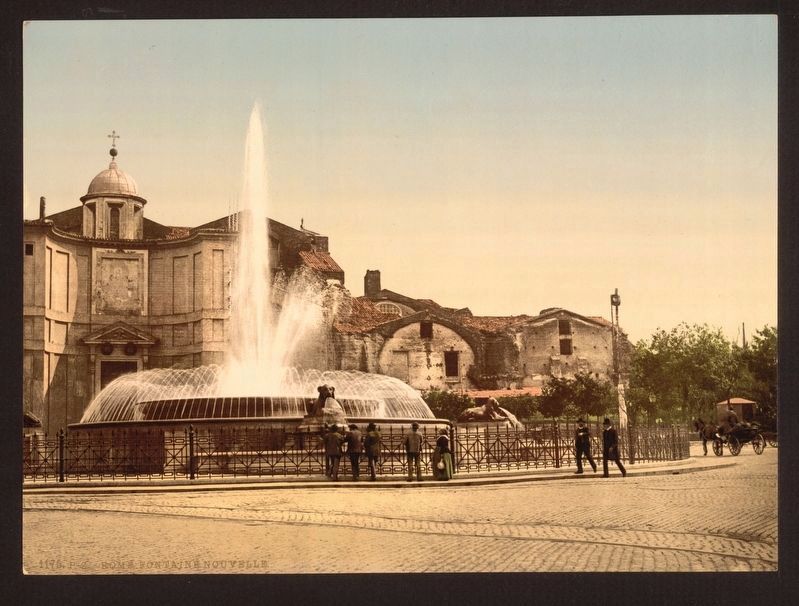Castro Pretorio in Roma in Città metropolitana di Roma Capitale, Latium, Rome, Italy — Central Italy (Tyrrhenian Coast)
Fontana delle Najadi / Najadi Fountain
Scultore: Mario Rutelli (1859-1941)
La fontana delle Najadi campeggia al centro di piazza della Repubblica, sorta alla fine dell'Ottocento nell'ambito del moderno rione Castro Pretorio. La piazza è anche nota come piazza Esedra (post 1880), poiché nel realizzarla si ripristinò l'originaria configurazione ambientale - ad esedra appunto - dell'emiciclo delle Terme di Diocleziano (298-306 d.C.).
Gaetano Koch vinse nel 1888 il concorso per la sistemazione di piazza della Repubblica, che si venne a configurare come uno spazio semicircolare porticato (uno dei pochi a Roma), valorizzato da una fontana circolare al centro, a precisare il punto di cerniera tra via Nazionale ed i collegamenti, con Termini e l'Esquilino. La fontana originaria si ricollegava simbolicamente alla funzione svolta dalla vicina Mostra dell'Acqua Felice, cioè la fontana del Mosè in piazza S. Bernardo, realizzata alla fine del Cinquecento da Domenico Fontana.
Con quest'ultima si celebrava infatti il ripristino dell'Acquedotto Felice promosso da papa Sisto V (1585-1590) - il nome stesso dell'acquedotto celebrava il pontefice, al secolo Felice Peretti -, così con la fontana di piazza Esedra si voleva ricordare l'Acqua Pia condotta dall'Acquedotto di Monte Mario, di cui era stato promotore papa Pio IX (1846-1878). Questi affidò ad Antonio Sarti l'incarico di derivare una vena acquifera dall'acquedotto dell'Acqua Paola, ricavato a şua volta ai primi del Seicento (per volere di papa Paolo V) ripristinando l'antico Acquedotto Sabatino, dell'epoca di Traiano. La Mostra dell'Acqua Pia fu poi sostituita dalla fontana che c'è ancor oggi, realizzata a partire dal 1885 da Mario Rutelli (autore a Roma anche del Monumento equestre ad Anita Garibaldi sul Gianicolo, di una scultura per il Monumento a Vittorio Emanuele II, del Monumento a Nicola Spedalieri in piazza Sforza-Cesarini).
La nuova fontana è perfettamente in armonia con la concavità della facciata della chiesa di S. Maria degli Angeli, ma soprattutto con la circolarità dello spazio classicamente posato e neocinquecentista della piazza. Questa era ormai divenuta una sorta di sbocco viario e visivo di via Nazionale; ma anche spazio scenografico destinato ad accogliere, la fontana delle Najadi, esempio di stile cosmopolita nonché la più importante fra quelle create a Roma dopo l'Unità d'Italia. La vasca inferiore (1888) è composta da un bacino mistilineo da cui sporgono quattro lunettoni, sui quali sono
posti altrettanti gruppi plastici in bronzo raffiguranti Ninfe su mostri marini (1901), si tratta in effetti di Najadi, cioè le Ninfe delle sorgenti, da cui l'appellativo della fontana. Originariamente il bacino superiore era coronato da un gruppo scultoreo con Tritoni, delfino e piovra, che fu successivamente spostato nel giardino al centro di piazza Vittorio Emanuele II (anch'essa nata dopo l'Unità d'Italia), accanto ai celebri Trofei di Mario.
Nel 1912 lo stesso Rutelli realizzò un nuovo gruppo plastico, ancora a sfondo marino: un Glauco che abbraccia un delfino, posto ancora oggi a coronamento della fontana dell'Esedra.
Didascalie
M.L. Ferrea - Pianta
Particolari
M.L. Ferrea - Prospetto
Sculptor: Mario Rutelli (1859-1941)
The Najadi Fountain sits in the middle of Piazza della Repubblica. It was built at the end of the XIXth cent., as part of a project to reconstruct the modern district of Castro Pretorio. The square also became known as Piazza Esedra as from 1880 because when it was being reconstructed, it was restored to the original "exedran" (or semicircular) shape that had existed in the Diocletian Baths (298-306 A.D.). Gaetano Koch won a competition in 1888, to find a solution
for the reconstruction of Piazza della Repubblica and it was entirely remodelled as a semicircular space with colonnades all the way round (one of very few in Rome), enhanced by a circular fountain in the centre, to emphasise the strategical importance of the square as a point of transit between Via Nazionale and other roads connecting up with Termini Station and the Esquiline district. The square's original fountain had the same symbolical function as the nearby "Mostra dell' Acqua Felice" (the Spouting of the Felician Water), which took the form of the Moses Fountain and is situated in Piazza San Bernardo, This fountain was executed by Domenico Fontana at the end of the XVIth cent. and was built to commemorate the restoration of the Felix Aqueduct, sponsored by Pope Sixtus Vth (1585-1590). Indeed the name of the aqueduct comes from this Pope's own real name, Felice Peretti. Likewise, the fountain in Piazza Esedra was built to commemorate the Acqua Pia (or Pian Water) that was brought from the Monte Mario Aqueduct, thanks to an operation sponsored by Pope Pius IXth (1846-1878). This Pope assigned Antonio Sarti the task of constructing a water pipeline to lead off from the Acqua Paola Aqueduct (or Pauline Water Aqueduct); that had in turn been commissioned by Pope Paul Vth at the beginning of the XVIIth cent. The idea was to restore the old Sabatine Aqueduct that dated back to
the time of Emperor Trajan. The Spouting of the Pian Water was then replaced by the fountain that may still be seen there today, work on which was begun in 1885 by Mario Rutelli, who also designed and executed the equestrian statue in memory of Anita Garibaldi on the Gianicolo Hill, one of the sculptures for the Vittorio Emanuele IInd Monument and the Nicola Spedalieri Memorial in Piazza Sforza - Cesarini. The new fountain is perfectly in keeping with the concave façade of the Church of Santa Maria degli Angeli, and above all with the semicircular design of the stately classical space of this Neo-Cinquecentesque square. The square had by then been turned into something of a visual focal point marking the end of Via Nazionale but it also provided a perfect theatrical stage set for the Najadi Fountain which is an example of a "cosmopolitan style" as well as being the most important fountain built in Rome further to the Unification of Italy. The lower basin (1888) consists of a mixtilinear basin from which four large lunettes extend outwards, containing four groups of bronze sculptures depicting Nymphs riding on sea monsters (1901). These in fact are the "Najadi", or Nymphs of the streams, whom the fountain is named after. The upper basin was initially decorated with a group sculpture depicting Tritons, dolphins and octopuses, but this was later moved to a garden in the centre of Piazza Vittorio Emanuele IInd (also built further to the Unification of Italy), alongside the famous "Trofei di Mario". In 1912 the same artist, Rutelli, created a new group sculpture, again with marine subject matter: the figure of Glaucus with his arms around a dolphin was what eventually came to crown the Esedra Fountain.
Captions
M.L. Ferrea - Plant
Details
M.L. Ferrea - Prospectus
Erected by Ministero per i Beni e le Attivita, Presidenza del Consiglio dei Ministri, Dipartimento del Turismo, Soprintendenza Archeologica di Roma, Soprintendenza ai Beni Ambientali e Architettonici di Roma, Comune di Roma, Assessorato alle Politiche Culturali, Sovraintendenza Comunale ai Beni Culturali, Assessorato al Turismo e Giubileo and Azienda di Promozione Turistica di Roma.
Topics. This historical marker is listed in these topic lists: Architecture • Arts, Letters, Music. A significant historical year for this entry is 1888.
Location. 41° 54.159′ N, 12° 29.825′ E. Marker is in Roma, Lazio (Latium, Rome), in Città metropolitana di Roma Capitale. It is in Castro Pretorio. Marker is at the intersection of Viale Luigi Einaudi and Piazza della Repubblica, on the right when traveling west on Viale Luigi Einaudi. The marker is located along the north side of the street. Touch for map. Marker is in this post office area: Roma, Lazio 00185, Italy. Touch for directions.
Other nearby markers. At least 8 other markers are within walking distance of this marker. St. Regis Grand (approx. 0.2 kilometers away); Church of Our Lady of Victory (approx. 0.3 kilometers away); Evangelical Methodist Church World War I Memorial (approx. 0.4 kilometers away); Manlio Gelsomini (approx. half a kilometer away); Via Genova (approx. 0.6 kilometers away); Palazzo delle Esposizioni (approx. 0.6 kilometers away); Federico Mistral (approx. 0.6 kilometers away); Palazzo Barberini (approx. 0.7 kilometers away). Touch for a list and map of all markers in Roma.
Credits. This page was last revised on July 29, 2023. It was originally submitted on July 28, 2023, by James Hulse of Medina, Texas. This page has been viewed 46 times since then and 7 times this year. Photos: 1, 2, 3. submitted on July 29, 2023, by James Hulse of Medina, Texas.
Editor’s want-list for this marker. A wide view photo of the marker and the surrounding area together in context. • Can you help?


